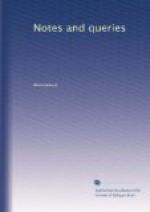Has any reader a Note whereby to tell who are the present representatives of Greenes of “Green’s Norton?” or who was “Richard Greene, Apothecary,” who was living 1770, and bore the arms of that family?
H.T.E.
[Our answer to our correspondent’s
first Query is, send your
Notes to us, who will print
and index them.—ED.]
* * * * *
BUSTS OF CHARLES I. AND JAMES I.—ANCIENT TAPESTRY.
1. Where is now the bust of Charles I., formerly in Westminster Hall, and engraved by Peter Mazell, for Pennant’s London, in which engraving the bust is attributed to Bernini, though Vertue thought differently? (See Dallaway’s Walpole, 1826, ii. 109.)
2. Also, where is the correspondent bust of James I., formerly at Whitehall, of which there is an engraving by N. Smith?
3. What has become of the tapestry of the reign of Henry VI. which formerly adorned the Painted Chamber in the ancient Palace of Westminster? It appears that it remained in one of the lower apartments from the time when it was taken down in 1800 until the year 1810; that it was then sold to Charles Yarnold, Esq., of Great Helen’s, Bishopsgate Street, for 10l. After his death in 1825, in the auction of his collection at Southgate’s (June 11. that year, lot 238), it was sold as “Seven pieces representing the Siege of Troy, for 7l. to Mr. Matheman.” Who was Mr. Matheman? and what has now become of his acquisition?
Another piece of tapestry in Mr. Yarnold’s possession, but it may be presumed in far better condition, was bought by Mr. Teschmaker, his executor, for 63l. This was described as “The Plantagenet Tapestry, in fine preservation, containing 23 full-sized portraits of the different branches of the Houses of York and Lancaster: among the most prominent are Margaret of Anjou; Cicely, Duchess of York; the Duke of Gloucester, afterwards Richard III.; Edward of Lancaster, Henry VI.; Earl of March, son of Richard (Duke of York and) afterwards Edward IV.; Henry VII.; Clarence [?] Duke of York,” &c. This description raises one’s curiosity greatly, and query, has this tapestry been elsewhere described? At the meeting of the Archaeological Association at Warwick in 1847, it was supposed to have come from St. Mary’s Hall, Coventry; but that idea seems to have arisen merely from its similarity of design to the tapestry which is now there.
N.
* * * * *
ORIGIN OF EPITHET “FACTOTUM.”
Sir,—The following expression in Cavendish’s Life of Wolsey, p. 42.—“He was {44} Dominus fac totum with the king”—seems to point us to some ecclesiastical origin for the derivation of our familiar word “factotum.” Does any one know the precise whereabouts of such a phrase in the Ancient Service books?
C.F.S.
* * * * *
INSCRIPTION ON ANCIENT ALMS-BASINS.




